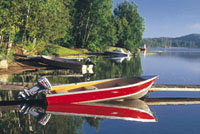Stock Photos
10 Pro Tips For Direct Marketing
Is there a serious photo
enthusiast out there who doesn't harbor a desire to see his or
her work published? Well, the vast majority I know would love to market
their images to books, magazines, and advertising agencies. In fact,
the most commonly asked questions during my seminars and photo tours
relate to getting started in stock photography. That's because
this is one facet of the business which can be operated on a part-time
basis, without giving up your day job. |
|||
2. Submit only your
best images. Unless you have a "once in a lifetime"
shot of an unusual subject, expect an instant rejection if your photos
are not extremely sharp. Check all of your slides or transparencies with
a 4x loupe as editors do, or preferably with a good 8x loupe to be absolutely
certain the image is razor sharp. Given the choice, photo buyers prefer
sharpness in all areas--plenty of depth of field. Avoid distracting out
of focus foreground elements especially. Naturally, all of this calls
for a tripod for most of your photography plus high quality lenses, flash
perhaps, stopping down when possible, etc. |
|||
4. Specialize in several
subject types. If you photograph only skiing, you will severely
limit the possibilities of your stock file. Diversify into at least five
categories to maximize the types of images to meet photo buyers'
needs. |
|||
6. Caption your images
accurately. A photo of a mountain climber used in advertising
may not require much background information, but the same image will need
a specific caption for editorial markets (at least the location). If you
photograph nature subjects, an accurate caption of the species, etc. is
a prerequisite for any sale. If you're not sure whether that rodent
was a chipmunk or a golden-mantled ground squirrel, get to a public library
and conduct the necessary research. Start by captioning your new images
and any older work as it is sent out to potential buyers. Trying to caption
10,000 slides already in your files is an exercise in frustration. |
|||
7. Get information
on current photo needs. Some magazines publish general Guidelines
for Photographers, available in return for a self-addressed stamped envelope.
This is a good start. Some publications also have "Want Lists":
monthly listings of immediate photo needs and you should ask for one.
In truth, getting a copy of full Want Lists from publishers is actually
quite difficult. After you have made several sales to a certain photo
buyer, do ask if they have a Want List and whether they would agree to
send you a copy regularly. If they perceive you as someone who has a huge
file of appropriate images--and can frequently fill their needs--they
will probably agree. |
|||
9. Consider the pros
and cons of a Stock Agency. Stock agencies perform a valuable
service in return for the commission (roughly 50 percent), and they do
have access to markets photographers cannot reach otherwise. However,
they generally have extremely high volume commitments. For example, one
agency requires 2000-3000 "marketable" (based on their criteria)
slides or transparencies as a start; then, they expect hundreds more every
month thereafter. While smaller agencies will accept fewer, most part-time
photographers still have difficulty generating an adequate supply on a
consistent basis. |
|||
References |























































